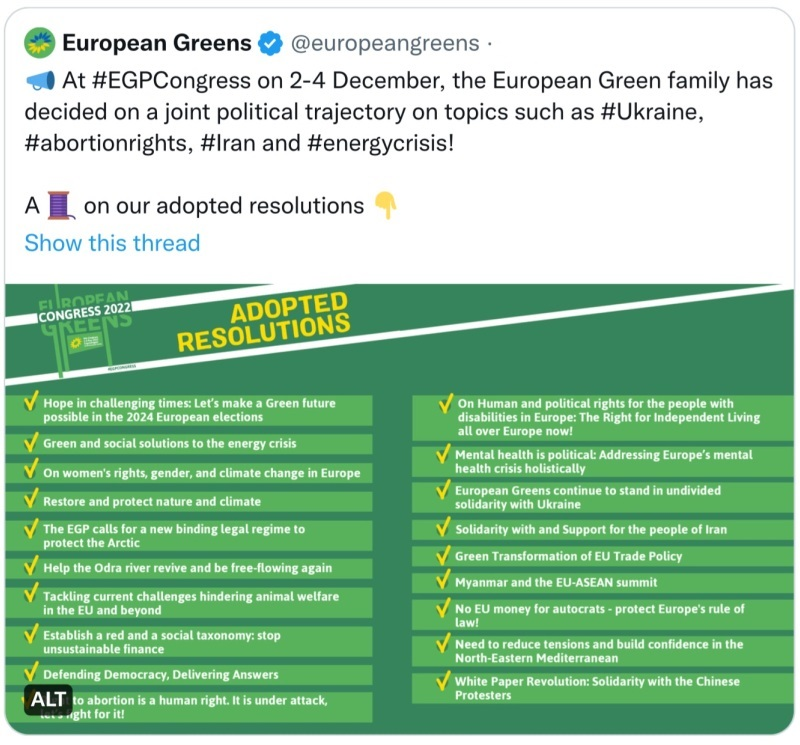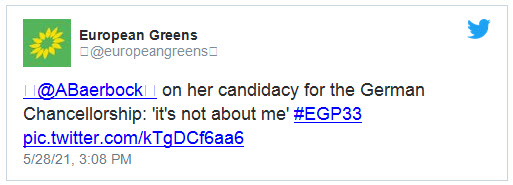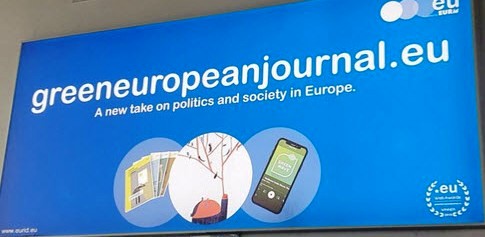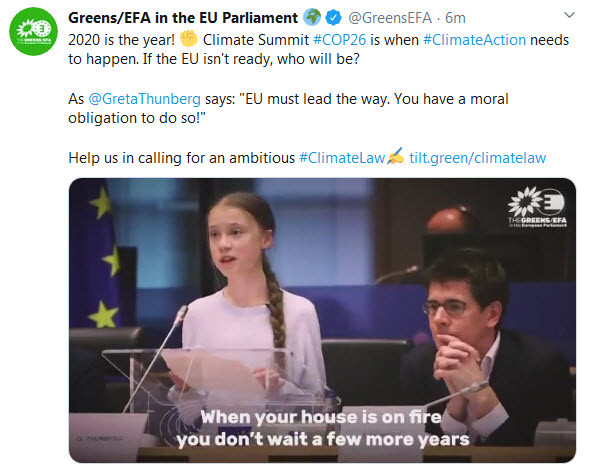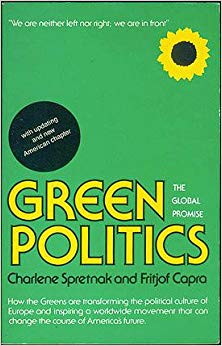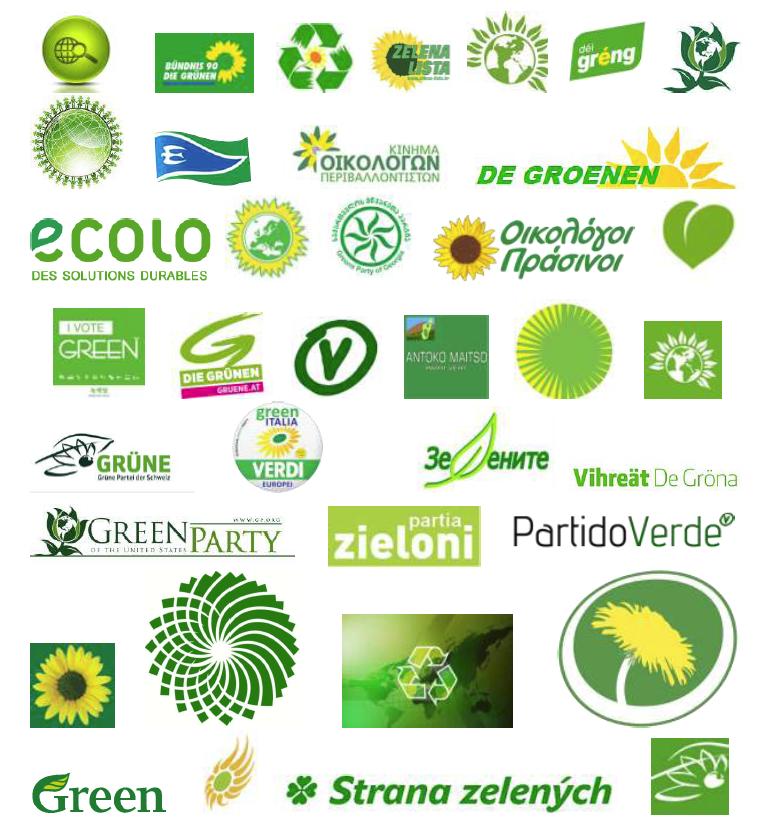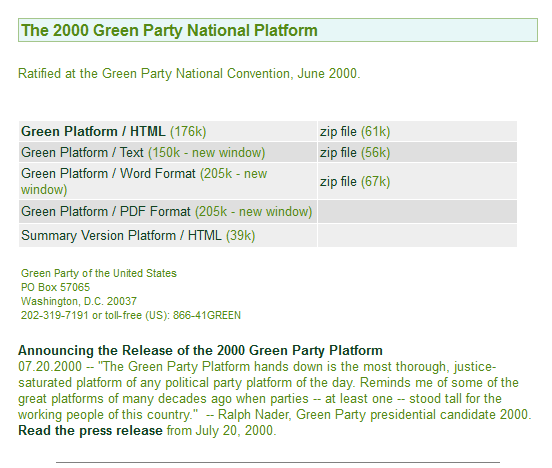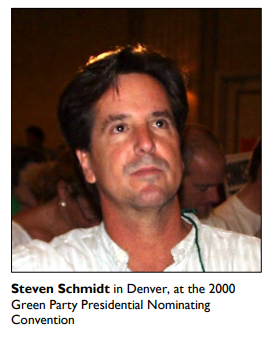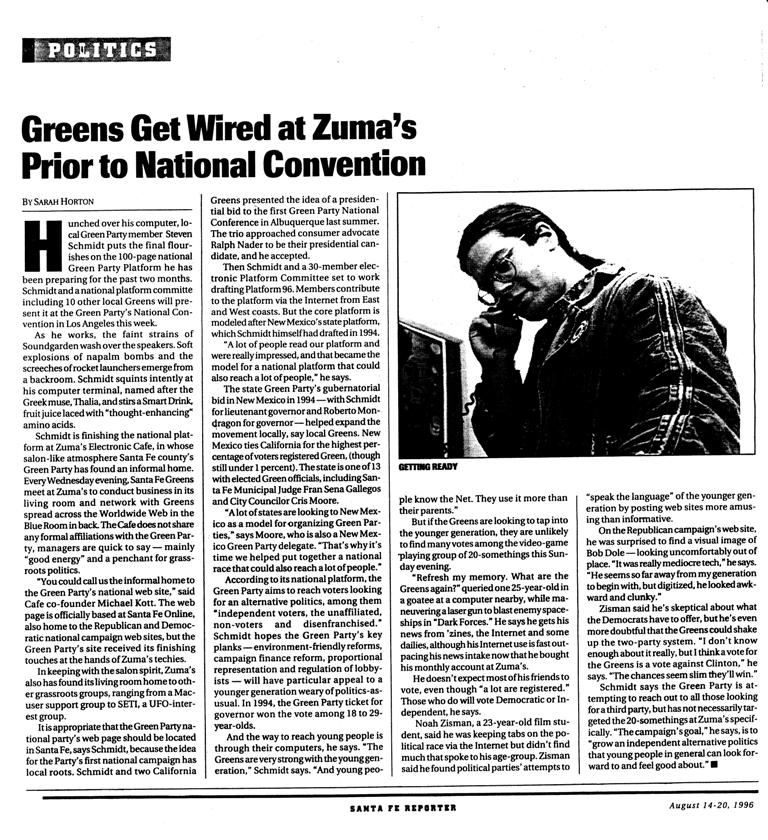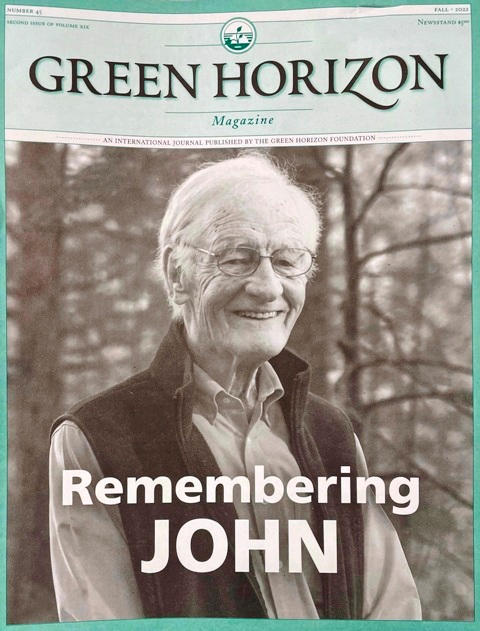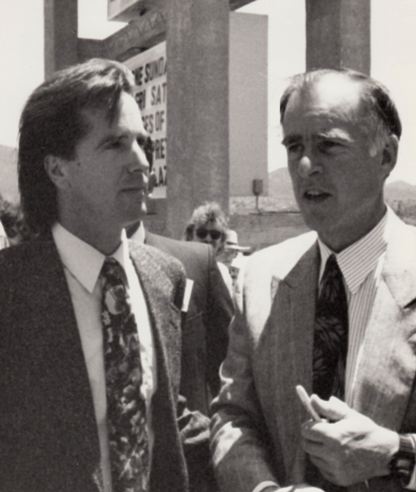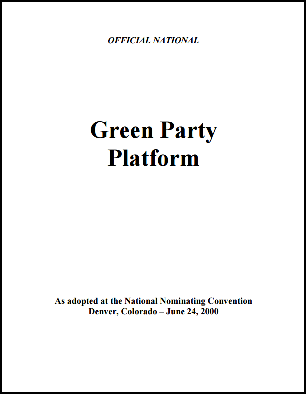Green Party
2023
U.S. Update:
An inside perspective: As green politics and green parties continue internationally to grow robustly, in the United States the current Green Party is unfortunately an outlier. Though the need for effective green politics is undeniable amid multiple challenges, ranging from the climate crisis, to threats on democracy, the US Green Party has floundered and collapsed. Throughout the years of the Green Party organizing in the US, a contingent, a faction, variously described as 'authoritarian left' had attempted to takeover the Green Party name and platform. Although this faction failed again and again from the mid 1980s to 2000, when a legal US Green Party and founding platform was approved, almost immediately the Green Party's candidate for president was persuaded by the faction to break his campaign promises and instead focus not on a 'big tent' but rather to become 'contrarian', break campaign commitments, and to focus his redirected campaign on Florida. The result was a profound setback to policies adopted and advocated in the founding Green Platform. Yet the faction that had been calling for a different political program, a vocal 'green on the outside, red on the inside' program, did not face the 2000 campaign debacle, the election results and consequences. The Green Party began a collapse then and the collapse has continued since. The U.S. Green Party is now 'mandated' by a small, self-declared "revolutionary, eco-anarchist" vanguard. The particulars of this group became a footnote in U.S. politics, after years of the faction's "Hawkins-Bookchin" blocking tactics, expropriation of the US national Green Party name, the rewrite of the founding platform, and break up of state Green parties. A rational Green Party green politics was a goal but over the years, amid tumultuous US politics, more extreme voices and actors have become a reality across the political spectrum. Even as a seriously rational green politics is needed, a successful, effective US Green Party is not on the scene and doing what a green politics with integrity, a rational green political voice, should be doing and accomplishing in these times.
The latest GPUS news includes an October 2023 story in Politico.
U.S. Green Party Presidential Ballot Status Drops to 18 States
After "eco-anarchist" takeover, U.S. Green Party's ballot access continues steep fall from a high of over 40 states to 18
Weeks after an announcement of his run for president in the Green Party, Cornel West abandons the GPUS
West discovers wide dysfunction within the GPUS, faction dogma, ideology, and lack of claimed ballot standing
Challenges of obtaining ballot access as an independent "in 50 states" loom as insurmountable (see Ballot Access News)
West is giving up critical ballot access initiatives and a Green Party organized volunteer effort by going independent. Daou has responded publicly, saying on X (formerly known as Twitter), “Cornel West aims to be on the ballot in 50 states. The Green Party has a ballot line in 18 states. The difference between being Independent and Green is 18 states, not 50.”
·································································
- 2022
Intro: Green parties have grown from beginnings in the 1980s over the past decades until now where we see Green Party formations in some 100+ countries. A global Green party coalition, and international Green party alliances such as in the European Union and Parliament are exemplary of Green realo/reality, an 'out in front' politics that varies country-by-country but shares core values and positions based on shared values.
In 2022, although in some countries such as the United States the Green Party has faded, in many countries an engaged Green Party voice has become stronger.
For years Greens in Europe, where the European Federation of Green Parties (EFGP) became the European Green Party, the challenges of today's generation -- the climate crisis, the resurgence of nuclear weapons and nuclear threats, war, conflict-, climate-and poverty-induced migration, environmental destruction, loss of species and biodiversity -- all the issues that are at the top of a Green politics agenda and policy platforms are being pressed forward with Green vision and constructive leadership.
European Greens | #EGPCongress
🌎
Focus now on the Foreign Minister of Germany... Annalena Baerbock... previously a candidate for Germany's Chancellor who is now confronting a Russia-Ukraine war and demands for new energy economics throughout Eurasia and globally.
Now consider the German Economy Minister...
November 30, 2022
Germany has formally decided to abandon an international energy accord that fossil fuel companies had used to oppose measures against climate change, the country's energy minister said Wednesday.
The move follows similar decisions by Italy, France, Spain and other European countries to leave the 1998 Energy Charter Treaty, which includes provisions designed to protect foreign investments in a country's energy sector.
“It's true that the Energy Charter Treaty is designed and acts against the Paris (climate) accord,” said German Economy Minister Robert Habeck, citing cases brought by German utility companies against the Dutch government's decision to end the burning of coal.
Habeck, a member of the environmentalist Green party, backed calls by climate campaigners for the European Union as a whole to withdraw from the pact...
🌎
Green Values, Global Green Politics
Within a global, diverse green political movement are many local and national green political groups. Their multiple threads form a tapestry of green ideas and beliefs.
Green parties and politics are exploring new directions and visionary ideas to bring positive, healthy change.
Varied as they are, their development carries potential for improvements needed across planet Earth.
Green parties offer real solutions in complex environments and seek to create a better, more sustainable world.
🌎
Recall that the German Green Party, out in front of some 100 Green parties internationally, led ‘ban the bomb’ opposition to nuclear weapons in Europe in the 1980s. The new German Foreign Minister, Annalena Baerbock, is a German Green Party leader. Green politics calls …
German Green Party Candidate for German Chancellorship
Front-runner in Polling to Merkel
🌎
Green parties in Europe respond to global COVID-19 pandemic
🌎
Green Party Origins
Beginning from the first Green groups in Australia (Tasmania thanks!) and New Zealand, to the powering up of the Green party movement in Europe, Green parties have a common bond -- shared Green Values. Green parties speak of our common humanity, interrelationships, and citizen activism.
The Green parties, with a few exceptions, have carried forward a belief in diversity, inclusion, not top/down politics, narrow ideology or factionalism, but a broad-based movement that presents a new vision beyond politics-and-business as usual.
One of the Green Party's founders expressed the Green vision as 'out in front' politics. This Green vision is shared by most Greens in different translations around the world.
Here are a few 'out in fronts' as they have been translated into English since the 1980s...
"Neither left nor right, but in front"...
"Neither left nor right, but forward!"...
"Greens are neither to the left nor to the right - they are in front"
-- Petra Kelly (English translations of formative calls to action...)
In memory of Petra Kelly: On the life of a founder of the Green Party
SJS / GreenPolicy360 Siterunner:
“We stand at a critical moment in Earth’s history, a time when humanity must choose its future. As the world becomes increasingly interdependent and fragile, the future at once holds great peril and great promise. To move forward we must recognize that in the midst of a magnificent diversity of cultures and life forms we are one human family and one Earth community with a common destiny. We must join together to bring forth a sustainable global society founded on respect for nature, universal human rights, economic justice, and a culture of peace.” - The Earth Charter (2000)
- Values-based Politics
Green Parties have organized as of 2014 in over 100 Countries
2018’s extreme heat, drought and wildfires are on all continents and hemispheres, impacting our livelihoods, agriculture and ecosystems with each heat record broken. In July 2018 alone we experienced 3,092 new daily high temperatures, 159 new monthly heat records and 55 all-time highs worldwide, according to the US’s National Oceanic and Atmospheric Administration. This includes the hottest 24-hour temperature ever felt on Earth, recorded in Oman (42.6℃), and Africa's hottest recorded temperature (51.3℃), in Algeria.
These record temperatures affect us in big ways; in July more than 300 people died from weather-related disasters and 45,700 people went to the hospital for heatstroke in Japan alone, according to Bloomberg. In Iran, the heatwave led to an unprecedented demand on the power grid causing more than 34,000 homes losing power. And in the United States, Europe and the Arctic droughts catalysed unprecedented wildfires.
The Global Greens Ambassador, Christine Milne, adds that “the Great Barrier Reef is dying and extreme drought besets Australia as the Northern hemisphere swelters and fires burn even in the Arctic, yet democracies beholden to fossil fuel corporations fail to respond fast enough. Across the planet, in whichever Parliament we stand, only the Greens say it is a climate emergency and call for systemic change, protection of the biosphere and rapid transition to net carbon zero and 100% Renewable Energy. The climate cannot wait. To ensure a healthy, safe future for people and the planet one must vote Green at every possibility - from Scandinavia to Sydney and from Santiago to Seoul.”
The Global Greens is the network of Green parties around the world working cooperatively at the local, national, regional and global levels to understand and address these issues through political action. The following statement gives an insight into the experience, impacts and urgency of climate change occurring right now in each region of the world.
In Europe - “Now - the climate cannot wait”
Sweden's local and national elections will be held on 9 September following the hottest and driest summer ever on record in Sweden, and the political parties are finding themselves in heated debate as well. Isabella Lövin, the Co-Spokesperson of the Green Party of Sweden Miljöpartiet de gröna (MP), remarks that Sweden’s political landscape is becoming increasingly aggressive and populist; where unfounded allegations, fake arguments and deliberate misinterpretations are the new normal, rather than a debate on facts and disagreement on substance. Miljöpartiet de gröna is prepared to have an honest debate with those who have different views. But to parties who still think everything is going to remain the same in a two degree hotter world, the Greens are telling them to wake up.
Miljöpartiet de gröna have been in Sweden’s national government the previous four years and has already delivered major advancements in climate adaptation and mitigation - including more than doubling Sweden’s climate and environment investments. MP also managed to pass new climate laws and new climate goals with broad political support. With current population scenarios, these goals imply that emissions in Sweden will be at one tonne per capita by 2045 by the latest. Sweden will now deliver emission cuts that go far beyond our EU-wide commitment in the Paris agreement and far beyond Kyoto protocol commitments.
MP wants Sweden to demonstrate to the world that a fossil-free welfare state with a strong and growing economy, and where we care for each other and the planet, is possible and that it is better and safer for all of us. There is no such thing as a free lunch. Nature can only give us so much, but we also have to give back only one small amount of decency towards animals, other people and future generations.
In the Americas
The Federation of the Green Parties of the Americas affirms that “preserving the ecosystems of Latin America and the Caribbean is essential to maintaining the ecological balance of the planet because this region has the greatest biodiversity and freshwater reserves on the planet. Effects of climate change and increasing temperatures have been impacting the region for decades, as evidenced by an increase in hurricanes, the retreat of practically all tropical glaciers and severe droughts in the Amazon. The largest emitters of greenhouse gases in the world, the major economies of the planet, have the main responsibility to solve the climate change crisis. Latin America and the Caribbean continue to affirm their commitment to the planet, to prevent deforestation and to advance the implementation of Green energy.”
Canadian Greens Leader and Federal Parliamentarian Elizabeth May adds that “Canada is acutely affected by climate change as well. Since 1948 Canada has warmed by 1.6 degrees, which is twice the global rate, and this is most pronounced in our western and northern regions. Our summers remind us of the devastating effects of wildfires. Drought, permafrost melt and disease are increasing problems for Canadians; and flooding endangers some 1.7 million Canadian households. In May 2018, the Federal Commissioner of the Environment and Sustainable Development released a report indicating that Canada is not on track to meet its climate change targets, including our commitment to the Paris targets. And yet the Liberal government is trying to buy two pipelines putting us further behind. The world needs climate leaders and the Greens have the courage, vision and ability to recognize and fix the problems.”
In Asia
The Korean Greens assert that “unless we work together with other countries to drastically cut greenhouse gas emissions, this will happen every year, and its intensity will grow. The Greens have consistently recognised that a climate change policy is needed to drastically reduce greenhouse gas emissions. The heatwave should awaken our societies to the urgency of responding to climate change. The government and all political parties should be working on meeting the Paris Agreement goal of keeping global temperatures beneath 1.5 degree Celsius above pre-industrial levels.”
Currently, global average temperatures are already over 1-degree Celsius above pre-industrial levels. Scientists warn that the hothouse trajectory we are on will make living conditions intolerable in many parts of the world, including a sea level rise that will submerge vast coastal regions under water. “It’s now urgent to greatly accelerate the transition towards an emission-free world economy,” concludes an international team of scientists. The Global Greens observes that deforestation is both a cause and consequence of climate change and thus local and global reforestation and climate programs should be implemented as a necessary component of national legislation. While global negotiations continue at COP24 in Poland this December on how to implement the Paris Agreement, the Global Greens calls on voters to vote Green in 2018 at local and national elections everywhere and at the EU elections in 2019 because climate change is now a matter of first priority for our politics.
························································
Green Dreams, New Politics, New Vision
From the outset, nonviolence and peace are Green core values that have been pursued across the political spectrum. In this way the Greens are neither Left nor Right; they work across-the-spectrum, out in front of conventional thinking...
············································································································
The Green Party
Green Politics, Local Parties, Global Reach
- A diverse movement based upon Green Values
- Out in front with forward-looking Vision
Green Parties - International List PDF / (List as of 2016)
Green Parties International List / Updated 2017
- Listings and links compiled by GreenPolicy360 are used by online sites such as Reddit, Wikipedia and multiple open-source/shared green websites and networks
- Permalink
○ ○ ○ ○ ○ ○ ○ ○ ○ ○ ○ ○
SJS / GreenPolicy360 Siterunner:
The Green Party internationally started up at the frontlines of the Cold War in Germany as an anti-nuclear weapons, anti-war peace and progressive movement.
Today nuclear weapons are again a critical political issue and one I've personally have been involved in and writing about since the 1960s. GreenPolicy360 and Strategic Demands are continuing to provide news and editorial opinion on escalating nuclear risks as a new nuclear arms race gather momentum. Although neither GreenPolicy360 and StratDem are formally assoc w/ any Green Party, your siterunner brings a history of green work to his writing and green networking. My drafting of the founding 2000 US Green party platform is an example of the diverse political work, although the US Green Party has moved far from the ideas foundation of the 2000 platform, an example of the many threads within green thought. Petra Kelly, one of the founders of the global Greens spoke of green politics of being "neither left nor right" on the political spectrum but "forward, in front" of conventional political thought.
The larger 'green' political world is bringing forward essential ideas and practices, led 'out in front' by Green Parties internationally.
The initial Green Party led anti-nuclear organizing work at the front lines of the Cold War. The Green Party continues at the forefront of anti-nuclear weapons efforts.
In alignment with Green Party policies of peace, GreenPolicy360 and its associate Strategic Demands are developing "New Definitions of National and Global Security"...
• https://www.greenpolicy360.net/w/Nuclear_Proliferation
• https://www.greenpolicy360.net/w/Nuclear_Nonproliferation
• https://www.greenpolicy360.net/w/Category:Nuclear_Nonproliferation
• https://www.greenpolicy360.net/w/Nuclear_Weapons
• http://strategicdemands.com/nuclear-issues-cold-war-2-0/
• https://www.greenpolicy360.net/w/Category:Strategic_Demands
• https://www.greenpolicy360.net/w/New_Definitions_of_National_Security
• http://strategicdemands.com/environmental-security/
• http://strategicdemands.com/new-definitions-of-security/
○ ○ ○ ○ ○ ○ ○ ○ ○ ○ ○
Green Party of the US
Founding US Green Party Platform
"The Green Platform hands down is the most thorough, justice-saturated platform of any political party platform of the day. Reminds me of some of the great platforms of many decades ago when parties -- at least one -- stood tall for the working people of this country." (Ralph Nader: July 2000 at the Green Party national convention)
"You must know that you were responsible for all this. All I did was accept.... Most of the issues and the subjects that the Green Party is adhering to are majoritarian positions in the United States of America and this is what commended the Green Party so much to those of us who were not in on the founding is that if you look very carefully at the Green Party platform, that's being proposed for your approval, this is by far the most comprehensive, broad-based platform that deals with the wide-range of systemic justice that's needed in this country. From the political to the corporate, to the cultural, to the civil liberties, civil rights, of any platform in the country." (August 1996 Green Party nomination acceptance speech)
🌎
"Who Founded the Green Party in the United States?"
by John Rensenbrink, Professor Emeritus, History & Politics, Bowdoin College
Professor Rensenbrink writes of 'essential founding work' by eight individuals, including GreenPolicy360's founder and current Siterunner -- Steven Schmidt (GreenPolicy360.com)
Green Horizon Magazine, Summer/Fall 2021
Steven Schmidt
U.S. Green Party Platform Chair, 1995-2001
Key drafter founding platform
Green Horizon: Steve promoted and ably defended the creation of the Association of Green State Parties in the early days of the nascent U.S. Green Party. In 1995 at a national gathering of Greens in New Mexico, he presented the "40-State Green Organizing Effort," a strategic plan that included a presidential campaign by state parties with a convention to be held in Los Angeles. The proposal was accepted and state parties moved forward with national organizing based on his plan. Steve chaired a new Platform committee from 1995 to 2001, during which time he structured and drafted a significant amount of the founding platform (which can be found at https://www.greenpolicy360.net/w/Category:Green_Platform). The official, founding U.S. Green Party Platform was an integral part of the subsequent successful submission to the FEC for national committee/party status.
🌎
Update: July 2021
SJS/GreenPolicy360 Siterunner: I was asked recently 'as a person who was a key drafter of the founding U.S. Green Party Platform' to speak to what I felt about changes made to the Platform recently as a faction in the U.S. Green Party changed the party's economic positions and recast the party's designation to an "eco-socialist party".
A central goal of the U.S. Green Party founding platform drafter, continuing for over twenty years since Charlene Spretnak's Values platform writing in the 1980s, is to create an expanded rights agenda, a Green agenda of environmental protection, of diversity and community. The founding goal was to build a "serious, credible political party on a platform serving as a foundation for a serious, credible -- and impactful -- political party in the U.S. and globally.
Here is what the founding Green Party Platform states, as it was officially voted upon, setting in place the founding values and policies of the U.S. national Green Party.
Here are a number of quotes from talks I have given about the Platform in the 1990s and since 2000. The intent of the new Green Party through the foundational platform was and is to provide a guide for green politics -- and continue as a factual source for communities online and in person who are looking to explore the Green Party's intent and origins...
The founding U.S. Green platform believes in values based politics, embodies a "rights agenda", constitutional rights, individual rights, free speech, a free press, freedoms, rights and responsibilities.
Our responsibilities as green citizens, planet citizens, U.S. citizens include acting for the common good and on behalf of 'the Commons'.
We see a big picture as planet citizens and, as a political party in over a hundred countries, a diversity of citizenships, communities, and diverse economies...
Stand up for human dignity, raise a banner of human rights.
Step up and advance ecological activism to protect and support a healthy living community.
Advocate for "Eco-nomics", diverse new economics, healthy and thriving communities.
Be a force against bigotry, unfairness, and discrimination.
Support democratic, civic values, the rights of a free and independent press.
Oppose authoritarianism, whether of the the left and right, oppose dictatorships and top down dictatorial politics.
Advance civil rights and voting rights.
August 2022
Update: From Steven Schmidt
Hannah was one of my teachers in the 1970s at the New School Grad Faculty. Two of her latin phrases stuck w me over the yrs - vita contemplativa and vita activa. I put them together as 'think before you act'. Later, in political writing, I added a moral dimension, a sort of Augustinian value-add that I called a 'values-based politics' and 'politics of values'. I've explained since the 1990s when I drafted a founding Green Party platform, and European-US 'common ground platform', that the platforms were drafted with a foundation in values, that is, I applied 'green key values' to issues that led, with integrity, to positions and policies on the issues.
These days (although the US Green Party has been taken over by self professed anarcho-revolutionary socialist types and the founding platform thrown out) I just keep on and have found millions who follow, interact with and share my green writing/work via GreenPolicy360.
Here's to vita activa' these days -- Read Hannah's work (especially her warnings) if you have a chance...
🌎
John Rensenbrink, a founder of the US Green Party
* https://en.wikipedia.org/wiki/John_Rensenbrink
Memory of John and Steve: John Rensenbrink called it a "mantra". The phrase he was talking about was "serious, credible, platform-based politics" and John Rensenbrink was referring to the 1990's period in the history of the U.S. Green Party. Nascent Green politics were put into a strategic plan at a national gathering of Green activists held in New Mexico and official legal status for a national party, a "serious, credible political party" was my professed goal. This was described by a Maine Green, a respected Green activist John Rensenbrink, as visionary. GreenPolicy360 siterunner was the "mantra-man" as I was beginning to draft the document that in 2000 became the official founding platform of the US Green Party. I would go on to often referring to the intent of the platform and party-information as a mantra... It was definitely a calling for new politics that would meet our generation's great challenges.
The Green platform was, in a way, continuing the work of a 1992 Brown presidential campaign platform, but went much farther. Your GreenPolicy360 Siterunner had worked with Jerry Brown in 1992 to draft a presidential platform and pushed forward a "We the People" campaign. The Green Party was enthused at the results and saw the Brown platform in a positive light.
I've written about this experience at length elsewhere, and how the Brown platform-in-progress led to my drafting of the founding platform of the new Green Party. In spite of the obstacles, the self-professed anarchists, revolutionaries, anti-capitalists and assorted extreme (and aggressive) ideologues were pushed back (although they returned to take over the Green party, but that's another story).
The initial founding platform of the US Green Party, that was voted on a convention in Denver in 2000 with a couple thousand folks involved, accompanied an application to the Federal Election Commission legally applying for national committee and party standing. John Rensenbrink, who was seen as a historian of the Green Party, in his years as a professor and his books chronicling the party's evolution, and its factions, was a supporter of the new platform. He chose to highlight how I described the work I did as a chair of the new platform committee from 1995-2000, that the platform that came out of a 'strategic plan' proposal presented in in NM in 1995 was altogether "serious and credible" and the growth of the green politics being advanced by the new Green Party was a politics based on values and that, as I said, the positions and policies that followed were "integral to Green values".
This would change, although the US Green Party platform had led to a "Common Ground Green" platform document between European Green parties (with the European Green Party Federation and later European Green Party) and the work to put forward a process for the first Global Green Charter, led by Australian Greens. This was before the US Green Party was taken over and turned away from serious, credible political work by a cadre of about a hundred in a so-called 'vanguard' who announced a socialist 'anarcho-revolutionary' takeover and their flag was hoisted over the party name.
A reality-based, or 'realo-politics' as some called it, was in John Rensenbrink's writing as well as the Green Party founding platform. John's last work that focused on a anarcho-contingent who for years blocked constructive work of the US Green Party, was published in Green Horizon Magazine before he passed away. He again pointed out the damage that those who took over the Green Party brought to US Green politics by a core group of ideologues. John's words, in the Green Horizon magazine, and the words of another professor and writer, Charlene Spretnak, who wrote in support of John's history about damage done by extreme ideologues and their dis- and mis-information, shouldn't be forgotten. The current US Green Party is a failed cadre that is far from the founding Green platform.
The reality check brings us to another mantra beyond Green "serious, credible, platform-based politics". This is another key phrase often thought of as a green idea -- this would be "think globally, act locally". It's a green idea through and through.
Let's discuss this phrase and its history -- https://en.wikipedia.org/wiki/Think_globally,_act_locally
I especially want to point to David Brower... and to the early 1970s when local and global political organizing led to what we called a 'whole earth point' of view.
Let's look back to beginnings...
Beginnings of the Modern Environmental Movement
In Brown campaign politics, in part a prelude to US Green politics, we were looking for solutions to problems, we were not waging a cultural war. We were leaders, in California and the world, on the environmental front.
Today, we should look again at California .... and I want to recall the Green Education Fund that brought together David Brower, Danny Moses, editor of Sierra Club publishing, and GreenPolicy360's founder, Steven Schmidt.
The 'think globally, act locally' message that each of us had put forward in the 1970s and 80s was still on our minds and the result was another organizing effort -- the Green Education Fund -- and the Tides Center in San Francisco.
My personal goals included helping a good friend, Carey Feierabend, NPS Deputy Director, in her work with the National Park Service to convert the Presidio from a military base to a national park -- part of what I saw, and wrote about during Jerry Brown's 1992 presidential campaign, as a "peace dividend". The Cold War was ending and much was possible. We envisioned many possibilities in our platform, the presidential campaign and platform of 1992, on how the US could convert to a peacetime economy -- and shift from the constant increases in war spending and nuclear arms planning and spending.
- Steve Schmidt with Governor Jerry Brown, 1992 US Presidential campaign,
- presenting Brown 'Platform-in-Progress' key policies at the Democratic Platform hearing
All of this bring back memories of how Senator Gaylord Nelson saw student anti-war, peace organizing in 1969, the Moratorium, and met with us and proposed what we supported and led to the first Earth Day.
We (with George E. Brown) proposed to 'take it to the next level' with Senator Nelson who was already looking at taking the lessons of the local and nationwide Moratorium activism into what we soon began calling "Earth Day".
On the 50th Anniversary
Memories on the Road to the First Earth Day
By Steve Schmidt
The Presidio’s Historic Origins
The roots of the Presidio go back to 1776, when Spanish soldiers used the area as the northernmost outpost in western North America. Eventually, the U.S. Army took control of the area that is now known as the Presidio in 1846, and built its own military post, according to the National Park Service.
The Presidio, which was designated a National Historic Landmark in 1962, has been part of the Golden Gate National Recreation Area since 1994. Interestingly, the Golden Gate National Recreation Area, which itself was the third most-visited site in the National Park System last year, features 37 distinct parks — including the Presidio, Muir Woods National Monument, and Alcatraz Island. The 80,000-acre recreation area supports 19 distinct ecosystems and is home to more than 130 miles of trails and 1,200 historic structures.
The conversion of the Presidio, from war to peace, was a profound success -- the conversion of the US to a peacetime economy and the holding of and conclusion to negotiations necessary to prevent a new 2.0 Cold War from heating up were less so... even as a member of the European Green Party is foreign minister of Germany as war rages in Ukraine, and a next generation of nuclear weapons rolls out, we remember how the Green Party was once a leader in anti-nuclear politics. Those days
are over...
The modern environmental movement -- from the famous December 1968 "Earthrise" Apollo 8 photograph that impressed upon us all that we were a living blue-green Earth, our home, our whole Earth was ours to be protected and preserved and for future generations.
Now we are faced with profound steps backward. The costs of war ramp up and the lessons learned in the past are being forgotten.
It is again time for "serious, credible, platform-based politics" and for all of us to "think globally, act locally."
○
“The goal of our founding platform was to have a Green Party policy foundation on which Green candidates could run ‘serious, credible, platform-based campaigns’, that is, to succeed in the goal of effective political campaigning taking the Green Party positions in the platform and turning them into reality.”
-- Steven Schmidt, NM and FL, Green Platform chair 1995-2001
GreenPolicy siterunner: Looking back, the US Green Party began with promise. Your GreenPolicy siterunner helped start up the US Green Party in the 1990s and later moved on to independent green work with the Green Institute, GreenPolicy360 and a number of environmental initiatives looking to advance a more diverse agenda of green politics and positions.
🌎
U.S. Green Party Political Update -- 2016
Steven Schmidt / Platform Committee Chair, 1995-2001, Key drafter, Founding Green Party Platform:
In the early days of the founding of the U.S. Green Party in the 1990s, a U.S. Green Party was envisioned that would become a positive political force in US politics, a "serious, credible, platform-based" party. In 2001 a national Green Party achieved legal, FEC national committee/party standing. Yet even as the Green Party arrived, the U.S. Green would again face takeover and crisis from within. As had happened in the 1980s with a takeover by a faction that called itself the Bookchin LGN, the Green Party is now, again, imploding.
For the record, in 2016, during the Jill Stein campaign for U.S. president, a radical change in direction for the Green Party was put forward in a 'North Caroline amendment' to the national Green Party founding platform. The economic diversity, economic justice positions in the Green Platform were replaced by an ideological group of advocates numbering about one hundred. Although the Green Party US website claims approx. 250,000 green party registered greens in states across the country about one hundred votes on this sudden amendment changed the Green Party as a diverse, green political voice into a new factional voice. The umbrella of green was replaced by eco-socialism, as promoted by a cadre going back in the Green Party to Murray Bookchin beliefs and ideology.
The takeover of the party by 'amendment' to the founding Green Party Platform was a move that changed the nature of the US Green Party from a 'big tent' with 'out in front' green activism, as some 100 of 250,000 Green registered members, said now it is "eco-socialistic" with "anarcho", "revolutionary" politics as the banner. The new version of this Green Party chose this cadre's leader, a self-professed #anarcho, #revolutionarysocialist, to run for president in 2020. The Green Party went from grassroots to vanguardism, from a big tent to a top down clique with little to no room for those who do not believe in the platform of the cadre now in control and now claiming the Green Party's name and previous green work and campaigns.
Although questions were raised about the democratic extent of the 2016 Green Party procedures and vote to re-make the basic beliefs and values of the US Green Party, the deed was done. An asterisk explanation to the North Carolina amendment noted that the new party was not calling for immediate 'expropriation' of property, but immediately the cadre went on a spree of misinformation and claims that were far from factual about the history of the Green Party.
Update: 2016 continued
The takeover of the US Green Party can be traced back to a 'social ecology' activist group, proponents of ideology attached to the work of Murray Bookchin. A cadre of 'Bookchinites' began actions in the mid-1980s intended to takeover the newly formed US Green Party. The cadre persisted in takeover attempts throughout the 1990s and into the 2000s, with the result being the deconstruction of a broader green political party. In 2016 remnants of the Bookchinite faction and others, with a few votes for an amendment to the founding Green Platform, achieved a radical re-definition of the US Green Party.
TGP 'vanguard' with a revolutionary banner would go forward as self-defined "eco-socialists", "anarcho", "green anarchists".
Phrases used by this group, this cadre, are described in a Wikipedia definition of "eco-socialism" and "green anarchism" .
Wikipedia: Eco-socialists are critical of many past and existing forms of both green politics and socialism. They are often described as "Red Greens" – adherents to Green politics with clear anti-capitalist views, often inspired by Marxism (red greens are in contrast to eco-capitalists and green anarchists). The term "watermelon" is commonly applied, often pejoratively, to Greens who seem to put "social justice" goals above ecological ones, implying they are "green on the outside but red on the inside". ...
Wikipedia: The main tendencies of green anarchism are: social ecology, which argues that environmental issues stem directly from social issues; deep ecology, which critiques anthropocentrism and advocates instead for biocentrism; and anarcho-primitivism, which advocates for the abolition of technology and civilization.
The radical change in direction for the U.S. Green Party, that acted in part to change US political history, was memorialized in what was described as a 'takeover' of the Green Party by this extreme cadre. The faction that influenced 2000 would soon come out as 'revolutionary'. Self-professed leaders of the so-called revolutionary tactics described themselves as #anarcho #revolutionarysocialists in hashtags and social media organizing. They put together a redo, redefining the U.S. Green Party's foundation platform and values statement and passed this deconstruction/redefinition amendment during the Stein campaign with purposeful intent. The economic diversity, economic justice positions in the Green Platform were replaced by an ideological group of advocates numbering about one hundred. Even as the vote was a small percentage of registered Green Party members (the Green Party US website claims approx. 250,000 green party registered greens in states across the country), the 'spoiler', 'block it and break it' politics, of this cadre, due to ballot access across the US arranged by Greens who had no relation with the Bookchinites, not was turned by the radical faction to their purposes.
The replacement of the economic positions of the U.S. Green Party was decided in an 'amendment' to the founding Green Party Platform, a vote described as by approx. 100 of 250,000 Green registered members.
The questions about the democratic extent of this vote to re-make the basic beliefs and values of the U.S. Green Party were lost as the cadre that pushed the profound change prevailed. The amendment noted that 'expropriation' of property was not immediately being called for. After years of work, outreach and discussion, debate and decisions from 1994 through to the founding platform in 2000, it bears emphasis that one hundred or so changed the foundation of US Green Party, in August 2016, from economic diversity and emphasis on economic justice in the 'real world' to another world view.
Economics of diversity, though widely supported, was rejected and replaced with a professed "Ideology" of "anti-capitalism" and "eco-socialism" (although these terms were not debated in the amendment to change the Green Platform.) Jill Stein set off in her campaign in an attack on the Democratic Party and she and her campaign begin to speak of 'giving Trump a chance'... the U.S. Green Party imploded.
Online and in Wikipedia, unnamed persons began in 2017 to re-label the US Green Party's "Ideology" as revolutionary, anarchist, and intended to end 'late-stage capitalism'.
The convoluted history of the US Green Party, at this point, began to radically shift back to the former structure of what was known as tG/GPUSA prior to the Bookchinite-group's demise in the 1990s.
Although the 2016 restructuring vote was challenged by many experienced Green Party members, the restricted amendment passed by about a hundred in the heat of the Stein campaign against Hillary Clinton and support among some for a Donald Trump option.
In 2018, one of the long-time players in the group that worked to restructure the national Green Party announced plans to run for the Green Party nomination for president, and to aim at a swing state strategy designed to take away votes from the Democratic candidate.
The question of the future Green Party politics crossed over into practical vs. ideological politics.
○
File:WHO FOUNDED THE GREEN PARTY IN THE UNITED STATES .pdf
One of the most serious mis-truths was from the 2020 presidential candidate who claimed online to be 'founder' of the US Green Party. He was not, and is not a founder, as a correction of the record establishes. Long-time Green and professor emeritus John Rensenbrink writes of this person as a "nemesis", not a founder
After years of work, outreach and discussion, debate and decisions from 1994 through to the founding platform in 2000, it bears emphasis that one hundred or so changed the foundation of US Green Party, in August 2016, from economic diversity and emphasis on economic justice in the 'real world' to another world view -- a professed "Ideology" of "anti-capitalism" and "eco-socialism" with Bookchinite faction in their decades long attempt to takeover the Green Party now a fait accompli. Online and in Wikipedia, unnamed persons began in 2017 to re-label the US Green Party's "Ideology" as: Anti-capitalism 2 and an economics of Eco-socialism 3
The mis- and dis-information about the Green Party's history unfortunately continues from this 'anti-capitalist, revolutionary cadre', although most all Greens in the U.S have no history with the cadre's line.
The convoluted history of the US Green Party includes a previous takeover attempt that was called "tG/GPUSA". This takeover attempt included a falsified filing with the FEC, which was rejected by that agency. A closer, factual look at the history of this LGN/'Bookchinite' faction had taken over the party structure in the late 1980s/early 1990s. The takeover failed and as tG/GPUSA collapsed in disorganization in the mid 1990s, a new national US party came into being. This official national party described in numerous historical documents included at GreenPolicy360 is now under assault again. So it goes in turbulent political times.
History will eventually produce the facts of a 'serious, credible platform-based' green party in the US, its visionary work to reveal the generational and existential threats to our common well-being and the many, engaged, activist solutions that the U.S. and international Green Parties have brought forward.
Out in Front, dealing with challenges and adversaries from without and within, the global Green Party, the only international political party now in over one hundred countries, carries on...
○
Green work, green action, local and global is our calling...
○ ○ ○ ○ ○ ○ ○ ○ ○ ○ ○ ○ ○ ○ ○ ○ ○ ○ ○ ○ ○ ○ ○ ○ ○ ○
- The Founding U.S. Green Platform and First Presidential Campaign
Presented to the German Historical Institute Conference in Washington DC
Published by GHI and the Boell Institute
"The Origins of Green Parties in Global Perspective"
- By Steven J Schmidt –– May 26, 2004
- The first decade of Green political party formation in the U.S., 1984–1994, was as tumultuous as it was promising. Green environmentalism and social activism from the 1960s and 1970s had produced a wellspring of support for green causes. Social reform activists explored links between environmental/economic sustainability and social justice. Deep ecology, bioregionalism and local community organizing, organic agriculture and alternative development, clean air and energy independence were among many branches of green political thought that flourished. Drawing on many threads of “green” organizing to build a “Green” political party was a natural progression that began in the late 1980s.
- The “Rainbow Coalition” of Jesse Jackson’s 1988 presidential campaign was, as some described it, the beginning of current Green national electoral efforts that looked to bring together a broad-based coalition of social justice and environmental voters. Jerry Brown’s 1992 “We the People/Take Back America” campaign adopted many themes from the Rainbow platform and ran a historically significant and competitive race against Bill Clinton, finishing a close second after winning the Connecticut primary but losing in New York after Governor Brown chose Jesse Jackson to be his vice presidential running mate.
- Greens were a prominent part of the Brown campaign, helping to draft the campaign’s platform and shaping much of the campaign’s effort to reach out and pull together a broad coalition that would substantially impact policy at the federal, state and local levels. The reform platform of the Brown campaign was presented at the Democratic Party platform hearings but was quickly set aside by the Democratic Party,¹ which, under the influence of the assurgent Democratic Leadership Council, chose publicly to take the party to the right and appeal to Reagan Democrats. The rightward slide of the Democratic Party and subsequent rise of Republican Party successes in federal, state, and local races can be traced to the 1992 shift in direction away from the traditional grassroots policy goals of Franklin Roosevelt’s presidency.²
- One of the principal goals of the Brown campaign focused on energizing a broad base of electoral support among progressives, fiscal liberals and forward-leaning conservatives. The platform envisioned many issue- and policy-oriented coalitions forming, such as a “blue-green” alliance that the campaign worked to build between blue-collar labor supporters and environmentalist/community activists around common-ground issues such as the World Trade Organization and the North American Free Trade Agreement. Many greens who were not active in the electoral arena began to glimpse the potential of a Green political party that would draw together many shades of green to form a powerful influence and direct the growing current of Green activism, electoral efforts and organizing.
- At the national level, a nascent Green party organization, The Greens/Green Party USA (G/GPUSA) had only about 1,000 dues-paying members by 1993–94. Support for the G/GPUSA was limited by its anti-electoral tendencies and organizational structure, process and direction, which took a line ascribed to “Left-Green” vanguardism and rejection of political party formations. The G/GPUSA organization was formally established at a 1992 meeting at Augsburg College in Minneapolis, MN, after a controversial vote the previous year at a Green national gathering in Elkins, WV. The organization’s structure, as described in many commentaries, was the product of prolonged and often acrimonious struggles to make decisions, bylaws and rules.
- The G/GPUSA’s ideological underpinnings were memorialized in the minutes of the 1992 meeting establishing the organization name, bylaws and working guidelines. Left-Green Network proposals put forward by Charlie Betz, Don Fitz and Howie Hawkins were adopted by attendees, few of whom supported electoral efforts. A dues-paying membership organization, where voting was limited under a structure of rules, mandates and other strictures, became known as the G/GPUSA model. Central to the organizing model was a belief that dues-paying activist members would, in effect, be the grassroots of the organization and would oversee state Green parties, candidates and campaigns. The G/GPUSA organization appealed to few Greens and quickly became insular and acrimonious. Its meetings were infamous for strident disagreement, member blocking under consensus rules and list and voting irregularities. By the mid-1990s the G/GPUSA had shrunk to a core group of members, locals and a few affiliated state Green parties.
- Most U.S. Greens chose not to join the organization, pay dues or agree to adhere to its bylaws/rules and working guidelines. The G/GPUSA rules, often described as Byzantine, maze-like or labyrinthine, were intrusive, overarching, complicated and considered by many to be unworkable. Activist members were given extraordinary oversight powers and could require explicit affirmations from candidates.
- Activists could order state parties and each other into dispute resolution. Grievance tribunals came and went. Mandates were 'de rigueur', as was binding mediation under threat of sanction. Any active member of the party could mount a grievance and demand accountability of candidates/campaigns/state parties or Green Party officeholders and representatives. Activist members defined themselves as the grassroots philosophically, and the rules/bylaws/working guidelines and practices of the G/GPUSA were extensions of this core organizational belief.
- A G/GPUSA program that described itself in its opening statement as a manifesto of the Green movement was adopted. A mélange of issues with imperative demands was addressed, with little attention given to local governance or domestic or foreign policy. Electoral-oriented Greens recognized that the G/GPUSA program was not intended to be a platform on which Green political campaigns could effectively run. The program was much more an expression of the ideological goals of numerous factions within the G/GPUSA. Activist members of the G/GPUSA often expressed disfavor toward policies referred to as reform or liberal. Greens seeking to run for office would regularly encounter activist members who held that candidates must report to activist members as a model of grassroots democracy. The members’ oversight model produced few candidates or campaigns.
- Locals, often composed of a few vocal, active, dues-paying Greens, spoke of bottom-up democracy. Core G/GPUSA members who advocated for municipalism blocked statewide and national campaigns as ideologically incorrect. As a result, most Green campaigns from 1992 to 1996 were run separately from the G/GPUSA organization (although these campaigns were subsequently claimed by G/GPUSA in a failed Federal Election Committee (FEC) filing [Sept. 1996] for national committee status).
- By late 1994 the contradictions and failures of the G/GPUSA model were becoming apparent to a wide cross-section of U.S. Greens. Individual state parties and Greens took on the challenge of envisioning and building a viable Green party distinct from the machinations and failures of the G/GPUSA. The New Mexico Green Party was a leader in this effort, as were Maine, California, Hawaii, Alaska and other state parties. In his books The Greens and Politics of Transformation and Against All Odds, John Rensenbrink says the Green Politics Network was established as an organization with an alternative vision to that of G/GPUSA.
- A federation of state Green parties was conceived in the 1990s as an inclusive, far-reaching way to build a U.S. Green Party. Maine advanced the concept of a triad model to combine “electoral, educational and movement” work. After the 1992 G/GPUSA decision in Minnesota, Rensenbrink and many others began talking about a different vision and definition, hoping to create a Green political formation offering Green values and positions.
- The challenge was to construct a successful model on which to build a growing, vital, U.S. Green Party. A model of party building would come from an unlikely place: a small state in the hinterlands far from centers of power. In 1994 in Santa Fe, named after St. Francis of Assisi, the patron saint of the land and animals, the New Mexico Green Party proposed a statewide slate of Green candidates who would run a “serious, credible” campaign based on their founding platform. The campaign became one of the most successful independent, third-party efforts in the United States in nearly four decades and became a model for the national Green “40 State Organizing Effort” launched in December 1994, which led to the founding of the national Green platform and first presidential campaign in 1996.
- New Beginnings
- A meeting in California between New Mexican Green Steve Schmidt and California Greens Mike Feinstein and Greg Jan set in motion a nationwide organizing effort by Greens in 1995–96. The California Green Party was the largest Green state party, and Schmidt carried with him a resolution passed by the New Mexico Green Council after the November 1994 election calling on California to make its 1996 primary ballot line available to a Green presidential candidate. This resolution was a core element of a national effort to place a Green presidential and vice presidential candidate on 40 state ballots.
- The New Mexico campaign convinced Schmidt that the “serious, credible, platform-based” model could be exported. Schmidt, who had been a senior adviser in the 1992 Brown campaign and key participant in drafting the platform, spoke of ballot access laws as impediments to third parties but pointed out that he and Roberto Mondragon received 11 percent of the general election vote in their campaign for governor/lieutenant governor and that the New Mexico Green Party as a result had gained ballot standing as a major party, the first minor party in New Mexico’s history to achieve this.
- The 40-state organizing proposal drafted by Schmidt and supported by New Mexico Greens set out a party-building model focused on creating a “serious, credible, platform-based” presidential campaign; a presidential nominating convention to be held in California; and a plan to “build the Green party” at the state and local levels through ballot access and petitioning drives. The presidential campaign would be a catalyst in building the party across states and localities. If motivated Greens could be contacted and mobilized, the 40-state effort would then reach out to environmentalists, social justice activists, labor, students, community groups, small- and mid-sized business—a broad coalition like that seen in the Jackson and Brown campaigns. The “take back America” message spoke to independents, who had come to number nearly 30 percent of the American electorate. Schmidt spoke of drafting a platform that would stand in opposition to militaristic, “one-party Democrat-Republican hegemony” and interject “ideals and ideas” in 1996 that would not otherwise be in the national debate.
- Greens began the work of identifying and polling contacts in every state to assess support for the 40-state effort and the new model for building a U.S. Green party nationally and at the state and local levels. In the mid-1990s, shortly after the collapse of the Berlin Wall and the end of the Cold War, the Green Party contrasted starkly with the Democratic and Republican parties, which advanced neo-conservative and -liberal positions aimed at furthering globalization and transnational corporate dominance.
- In 1994, in a historic shift of political power, a wave of Republican victories led to control of Congress for the first time in 50 years. The Grand Old Party under Speaker Newt Gingrich looked to the South, social conservatism and a renewed military buildup. The “Contract with America” and Reagan-era social and economic agenda prevailed, while the Democrats abandoned long-held policies like the right to universal health insurance and health care. Democrats attempted to step up corporate political contributions even as insurance/health care proposals were devastated by these same contributors. The extent of lobbying and the amount of money contributed were unprecedented.
- The Democratic Leadership Council continued to push the Democratic Party to the right in the 1990s attempting to win back “Reagan Democrats” even as the Democrat’s adoption of Republican policies relegated the party to the backbench. Republicans effectively moved to consolidate control of the political agenda as Democratic opposition retreated. The underpinnings of U.S. policy over the decade were set in place as Democrats adopted core Republican Party positions and each party accelerated their outreach to corporate and conservative interests.
- Against a background of rightward-shifting U.S. politics, the U.S. Green Party launched a vigorous effort to create an alternative vision to a duopoly of “Republicrat” politics. It was increasingly evident that a serious challenge to two-party dominance of American politics was needed. If the Green Party was to enter the political arena as a serious, credible challenge to the politics-as-usual, it had become evident that it would first have to confront its own politics.
- At the 1995 national Green gathering in Albuquerque, NM, the dissension in the Green Party between the radical, membership-based G/GPUSA organization and state parties like New Mexico and California reached a tipping point when a G/GPUSA caucus met in an attempt to ‘nominate’ Mumia Abu Jamal, a convicted felon on death row. The G/GPUSA members attempt to mandate that state parties place Mumia’s name on their respective state ballots in 1996 as the nominee of the G/GPUSA was defeated.
- The bylaws/rules of the G/GPUSA were subsequently challenged and, after the New Mexico gathering, never again would the G/GPUSA successfully act as if it were the legitimate national Green Party. Claims the organization made the following year to the Federal Election Commission were set aside. The 1995 split in the Green Party between those who wanted a nomination process by state parties according to election laws, with serious, credible candidates legally able and willing to run, set the stage for the 1996 presidential campaign and formation of the Association of State Green Parties.
- At the 1995 New Mexico gathering in the Great Kiva, a traditional Native American place of reflection and decision, the assembled Greens heard the results of a national survey which strongly supported running a presidential campaign in 1996. The three presenters of the “40-State Organizing Proposal”, Mike Feinstein, Greg Jan and Steven Schmidt, spoke of a short list of potential candidates. They suggested Greens consider Jim Hightower, a well-known Texas populist and nationally respected writer/speaker, labor advocate and radio personality; Delores Huerta, a Latina activist from California who had over several decades, beginning with Caesar Chavez, proven her courage and political capabilities; and Ralph Nader, the incorrigible campaigner for consumer causes who had taken on the biggest corporations and congressional barter in the name of a revitalized civic democracy.
- The assembled Greens voted their support of the 40-state effort, and shortly thereafter a series of meetings was held to discuss the national organizing plan. Key would be navigating the intricate and restrictive ballot access laws in each of the states. Richard Winger, the editor of Ballot Access News, became an indispensable resource. Dates and petition requirements were sent to organizers in every state. At the same time, the platform process led by Schmidt commenced in Santa Fe. First consulted were state party platforms; the 1988 “Rainbow” and 1993 “We the People” platforms; historic, constitutional documents speaking to the foundation of American liberty as a revolutionary ideal; civil rights speeches; blue-green alliances; environmental books; and works of groups like the Bioneers. The ad-hoc committee drafting and redacting went online and set up forums for discussion/debate with the assistance of long-time Green and webmaster Cameron Spitzer. Schmidt acquired the domain gp.org and began an extended process to draft a platform that Greens would approve and that would become the foundation of a platform-based 1996 campaign.
- The outreach to Hightower, Huerta and Nader was conducted with due speed and in good faith by the 40-state organizers and supporters like Rob Hager in Washington, DC, who almost camped out at Nader’s office in an attempt to convince him of the merits of a run. Other supporters of a national Green presidential campaign, such as Linda Martin and Tom Linzey, also lobbied Nader, and Third Parties 95/96, formed by many of the same Greens, encouraged Nader to enter the race. Green activists like Annie Goeke relayed international voices of support. An open letter from a range of supporters across the political spectrum urged Nader to run. After much back and forth discussion about the scope of his campaign, Nader chose to run a limited campaign, but one of substance.
- At the Green’s first national convention, held at the University of California in Los Angeles, a university system former Governor Reagan had publicly stated he would punish and dismantle for its protest of the Vietnam War, Ralph Nader gave his acceptance speech on August 19, 1996.
- He held the platform up and repeated what he had been saying throughout the day in a series of press interviews — that he was running as the Green presidential nominee because of the ideas and positions in the platform; that he was running to turn the ideas and positions of the platform into reality.
- ○
- Nader began his acceptance speech after a prolonged welcoming ovation:
- “You know that you are responsible for all this. All I did was accept. Some of the prior speakers touched on a number of issues and as I was listening to them, what occurred to me was that most of the issues and subjects that the Green Party is adhering to are majoritarian issues to the United States of America. And what commended the Green Party so much to those of us who were not in on the founding is that if you look very carefully at the Green Party Platform that’s being proposed for your approval, this is by far the most comprehensive, broad-based platform that deals with a wide range of systemic justice that’s needed in this country: from the political, to the corporate, to the cultural, the civil liberties, the civil rights platform of any party in the country. I wouldn’t begin to compare it with the flaccid, insipid, empty, cowardly platforms of the Democratic and Republican Tweedle-dum and Tweedle-dee parties… As a matter of fact, the Democratic Party Platform doesn’t even contain an affirmation of universal health coverage for all Americans. It even backed off of that. While they took money from the hospital lobby, the medical lobby, the drug industry lobby, the giant HMO’s, and insurance lobby. And as far as the Republican Platform goes, this one could’ve been written by the Fortune 100.”
- The Nader campaign that left the campus that day would form the core of a Green campaign of ideas and ideals. The results of the 40-state 1995–96 organizing effort led to new state parties being formed, existing ones revitalized and, one month after the November election, the formation of the Association of State Green Parties that was to become the Green Party of the United States. In December, at a post-election meeting in Middleburg, VA, close to where Thomas Jefferson farmed, the representatives of the state parties gathered to announce a newly structured national party.
- This was a foundation to build on, and the party grew broadly. State parties were affiliated, national meetings were held, a formal relationship and platform were approved between U.S. and European Greens and, with the assistance of Tom Linzey, Dave Cobb, Steve Schmidt and Dean Myerson, a 300-plus page application to the FEC was filed that led to a legal advisory option. The national Green Party, a “national committee of a national party,” had arrived.
- ○
- Postscript:
- Today, the Green Party has grown from some 60 Green candidates for office in the mid-1990s to well over 400. Greens continue growing a unique political party combining electoral/movement/educational work, yet face a barrage of obstacles and legal barriers to full participation by minorities, minor parties, independents and all who have walked away from a rigged system rewarding incumbents, power brokers, wealthy contributors and lobbyists.
- In the near term, the U.S. Green Party no doubt will continue challenging the winner-take-all U.S. voting system. A break in the bulwark of incumbent party opposition to voting reform can be found in public recognition of the failings of the 2000 presidential election and disenfranchisement and voting irregularities that produced a president with a troubling victory. The U.S. electorate is becoming increasingly aware of how elections are conducted, how voters and votes are manipulated and how difficult it is to oppose the system in place. The U.S. Green Party is speaking to this core issue by its very existence. Having established itself as a serious, credible force in American politics and a voice of opposition to politics- and business-as-usual, the Green Party now faces the challenge of being a consequential force in politics. As a result of the 2000 campaign, the Green Party has come to be perceived as a swing vote, and, along with independent voters who continue to grow in numbers as the two-party system fails to garner wide support or commitment, the Greens and independents will increasingly exert perceived and real political leverage. If the Greens choose to continue working toward making the platform a political reality, then much will continue to be possible.
- One of the leading issues will be proportional voting, preference and instant run-off voting, which are moving to the forefront of many of Green’s agendas. The Green Party’s platform positions on electoral and political reform, alongside positions taken by allies like the Center for Voting and Democracy/FairVote, League of Women Voters, Common Cause and other public interest groups, will undoubtedly play an increasing role in shaping the future U.S. political arena. The European Greens, who have proportional voting systems, will no doubt keep a close eye on progress toward opening up the American political system to Green, independent and opposition points of view.
- ___
- ¹ Chapter 4, “An Insurgent Campaign,” from American Twilight, by Steven Schmidt, ©July 2003.
- ² During the eight years of the Clinton administration, the Democratic Party lost more political races and offices at the federal/state and local levels than at any time since the 1890s’ presidency of Grover Cleveland, which led to the election of William McKinley and the historic period known as the “Age of the Robber Barons.”
- Sam Smith, editor of Progressive Review (http://prorev.com), wrote of Clinton’s record:
- Here's what happened to the Democrats under Clinton, based on our latest figures.
- o GOP seats gained in House after Clinton became president: 48
- o GOP seats gained in Senate after Clinton became president: 8
- o GOP governorships gained after Clinton became president: 11
- o GOP state legislative seats gained since Clinton became president: 1,254 as of 1998
- o State legislatures taken over by GOP after Clinton became president: 9
- o Democrat officeholders who have become Republicans since Clinton became president: 439 as of 1998.
- Since Clinton was inaugurated, the Democrats have lost 12% of their registered voters, and lost during his administration the largest number of seats in Congress, the governorships, and state legislatures of any Democratic White House incumbency since Grover Cleveland.
Green Values and the Environmental Movement Bring Forward a Green Party in the U.S.
SJS / Siterunner: The origins of the US Green Party can be found in initial gatherings and the writings of founding Greens. The "Key Values" work of Charlene Spretnak and up front voices of environmental, progressive women in the 1980s has special meaning. The key values writing became a foundation document that led to key values language drafted and carried forward into the founding Green Party platform passed in 2000. I often speak of the Green party as "values-based politics" and Green values, especially ecological wisdom, the first of the original key values, and non-violence, a foremost goal, remain at the center of the Green platform.
• http://www.greenpolicy360.net/w/Category:Green_Values
Revisiting the original key values of the Green Party of the US, published in Charlene Spretnak's book - The Spiritual Dimension of Green Politics
• http://www.greenpolicy360.net/mw/images/Green_Key_Values_Spiritual_Dimensions-Spretnak-1.pdf
• http://www.greenpolicy360.net/mw/images/Green_Key_Values_Spiritual_Dimensions-Spretnak-2.pdf
• http://www.greenpolicy360.net/mw/images/Green_Key_Values_Spiritual_Dimensions-Spretnak-3.pdf
We are all connected...
• https://www.greenpolicy360.net/w/File:Relational_Reality_by_Charlene_Spretnak.png
- The Ten Key Values of the Green Party
* Originally approved at the Green Party Convention in Denver, Colorado, June 2000
1. GRASSROOTS DEMOCRACY Every human being deserves a say in the decisions that affect their lives and not be subject to the will of another. Therefore, we will work to increase public participation at every level of government and to ensure that our public representatives are fully accountable to the people who elect them. We will also work to create new types of political organizations which expand the process of participatory democracy by directly including citizens in the decision-making process.
2. SOCIAL JUSTICE AND EQUAL OPPORTUNITY All persons should have the rights and opportunity to benefit equally from the resources afforded us by society and the environment. We must consciously confront in ourselves, our organizations, and society at large, barriers such as racism and class oppression, sexism and homophobia, ageism and disability, which act to deny fair treatment and equal justice under the law.
3. ECOLOGICAL WISDOM Human societies must operate with the understanding that we are part of nature, not separate from nature. We must maintain an ecological balance and live within the ecological and resource limits of our communities and our planet. We support a sustainable society which utilizes resources in such a way that future generations will benefit and not suffer from the practices of our generation. To this end we must practice agriculture which replenishes the soil; move to an energy efficient economy; and live in ways that respect the integrity of natural systems.
4. NON-VIOLENCE It is essential that we develop effective alternatives to society’s current patterns of violence. We will work to demilitarize, and eliminate weapons of mass destruction, without being naive about the intentions of other governments. We recognize the need for self-defense and the defense of others who are in helpless situations. We promote non-violent methods to oppose practices and policies with which we disagree, and will guide our actions toward lasting personal, community and global peace.
5. DECENTRALIZATION Centralization of wealth and power contributes to social and economic injustice, environmental destruction, and militarization. Therefore, we support a restructuring of social, political and economic institutions away from a system which is controlled by and mostly benefits the powerful few, to a democratic, less bureaucratic system. Decision-making should, as much as possible, remain at the individual and local level, while assuring that civil rights are protected for all citizens.
6. COMMUNITY-BASED ECONOMICS AND ECONOMIC JUSTICE We recognize it is essential to create a vibrant and sustainable economic system, one that can create jobs and provide a decent standard of living for all people while maintaining a healthy ecological balance. A successful economic system will offer meaningful work with dignity, while paying a “living wage” which reflects the real value of a person’s work. Local communities must look to economic development that assures protection of the environment and workers’ rights; broad citizen participation in planning; and enhancement of our “quality of life.” We support independently owned and operated companies which are socially responsible, as well as co-operatives and public enterprises that distribute resources and control to more people through democratic participation.
7. FEMINISM AND GENDER EQUITY We have inherited a social system based on male domination of politics and economics. We call for the replacement of the cultural ethics of domination and control with more cooperative ways of interacting that respect differences of opinion and gender. Human values such as equity between the sexes, interpersonal responsibility, and honesty must be developed with moral conscience. We should remember that the process that determines our decisions and actions is just as important as achieving the outcome we want.
8. RESPECT FOR DIVERSITY We believe it is important to value cultural, ethnic, racial, sexual, religious and spiritual diversity, and to promote the development of respectful relationships across these lines.
We believe that the many diverse elements of society should be reflected in our organizations and decision-making bodies, and we support the leadership of people who have been traditionally closed out of leadership roles. We acknowledge and encourage respect for other life forms than our own and the preservation of biodiversity.
9. PERSONAL AND GLOBAL RESPONSIBILITY We encourage individuals to act to improve their personal well-being and, at the same time, to enhance ecological balance and social harmony. We seek to join with people and organizations around the world to foster peace, economic justice, and the health of the planet.
10. FUTURE FOCUS AND SUSTAINABILITY Our actions and policies should be motivated by long-term goals. We seek to protect valuable natural resources, safely disposing of or “unmaking” all waste we create, while developing a sustainable economics that does not depend on continual expansion for survival. We must counterbalance the drive for short-term profits by assuring that economic development, new technologies, and fiscal policies are responsible to future generations who will inherit the results of our actions.
A special tip of our GreenPolicy hat h/t to the vision of Charlene Spretnak of California and Petra Kelly of the German Green Party (German: Bündnis 90/Die Grünen or Grüne)
○
Green Party / United States
Green Party of the U.S. / Document Collection @Scribd
__________________________________________________
SJS / Siterunner: Our formative U.S. Green Party, after the 1996 campaign, reached out to European Green parties and I worked via our new U.S Green Party Platcom to draft a first-ever Green Parties "Common Ground" Platform document articulating core, shared U.S./European Green party values and positions.
The following document memorializes what we presented that was approved and passed in Paris in 1999.
US-European Green Parties Common Ground Platform Archive Link
ASGP*/EFGP* GREEN COMMON GROUND STATEMENT
The Association of U.S. State Green Parties* and European Federation of Green Parties Approve a First-Ever "Common Ground Platform"*
Presented/Passed at the 2nd Congress of the European Federation of Green Parties - February 1999 by SJS / Siterunner
*The ASGP is now the Green Party of the United States -- http://www.gp.org
*The EFGP is now the European Green Party -- http://europeangreens.eu/front
Followed by the Global Green Charter
Adopted in Australia in 2001, updated in 2012 and 2017
_______________________
SJS/GreenPolicy360 Siterunner: The new U.S. Green Party in formation reached out to the European Green Party in formation with the following U.S. and European Green Parties "Common Ground Platorm":
COMMON GROUND TEXT
INTRODUCTION
The evolving relationship of the U.S. Greens and European Federation of Green Parties is cause for great optimism. The partnership of the Association of U.S. Green Parties (ASGP) and Committee of the European Federation (EFGP) is in its initial formative stages. As we continue to grow in strength and numbers, we submit that the future of political thought will look to our Green ideas and values as a foundation for political action.
Our responsibility is to challenge conventional wisdom and create a climate of political change. As humankind approaches the beginning of a new millennium, Greens globally will continue to press for comprehensive expansion of rights, for social justice, peace and the protection of our common heritage and environment.
At this historic moment, with vision and purpose, we advance our first mutual platform document - a U.S./European "Green Common Ground Statement".
________________________
HUMAN AND CIVIL RIGHTS
We believe that the inherent dignity and the equal and inalienable rights of all members of the human family is the foundation of freedom, justice and peace in the world.
We recognize that clean air, clean water, fertile soil, diverse plant and animal life, and the ability to derive a living from the bounty of the earth is a birthright of all living beings.
We believe that all people have a right to food, housing, education, medical care, a living wage job and support in times of hardship.
We oppose all forms of discrimination based on race, gender, religion, nationality, age, or sexual orientation. We support the rights of all individuals, regardless of ability, to strive for personal fulfillment and to live with dignity.
We support civil liberties that are the basis of individual freedom: freedom of speech and information; the right to peaceful assembly; freedom of religion; the right to vote in democratic elections; the right to fair public trial and open, humane and accountable legal processes.
We support a woman's right to full reproductive choice.
We support the right to asylum and refugee status.
We condemn the use of torture and the death penalty.
We condemn child labor and the oppression of women through forced prostitution and sterilization.
PEACE AND INTERNATIONAL RELATIONS
We believe the ever-growing expansion of unregulated, inappropriate-scale profit-making interests, the limits of the resource base that these interests are trying to control, and the proliferation of weapons of mass destruction pose a dire and imminent threat to world peace. As technology and commerce increase the depth and complexity of global relations, individual nations need to work together to develop multi-national responses to global issues that spring from shared values of peace, justice, community, democracy and ecological sustainability.
We call for international relations that favor cooperation and support over competition and exploitation. We believe that, as a matter of principle, considered diplomacy should always be favored over recourse to military intervention and violence.
We support the formation of international alliances and non-governmental organizations to work to find peaceful and sustainable solutions to the global problems of war, environmental degradation, oppression and poverty.
We support immediate decommissioning of all nuclear weapons production facilities, date-specific destruction of all nuclear weapons, and the signing of oversight treaties calling for drawing down of nuclear stockpiles.
We call for a ban on the development, production, sale and use of land mines, chemical and biological weapons, and other weapons that bring indiscriminate destruction to civilians and the environment.
We oppose the use of economic sanctions which bring suffering and death to innocent civilians.
THE GLOBAL ECONOMY
We call for benchmark social and environmental standards to be goals at all levels of economic decision-making -- local, national, and international.
We support the right of local governments to set higher social and environmental standards than those set by international trade organizations and treaties.
We support the right of workers to form collective bargaining units; the right to a fair living wage; and right to safe, healthy working conditions.
We reject agreements that negotiate downward our basic environmental, human rights, health, safety and labor standards, and prohibitions against child and forced labor.
We reject trade agreements negotiated in secret and/or unduly influenced by mega-corporate interests such as the Multilateral Agreement on Investments (MAI), the General Agreement on Tariffs and Trade (GATT), and the North American Free Trade Agreement (NAFTA). Treaties such as these are threats to local autonomy, and limit the participation of citizens in decisions affecting the economic and environmental health of their communities. Increased mobility of capital and commodities is being coupled with decreased mobility of people. National and local authorities are losing power to an international "empire of wealth". We call for a vigorous international campaign for economic democracy -- political change that supports environmentally and socially sustainable economic systems.
It is our belief that the massive debt owed by the Third World is causing immense misery and environmental destruction. Foreign aid must be addressed in the context of retiring this debt and in this regard "structural adjustments" must not be forced on the economies of the underdeveloped world via the International Monetary Fund, World Trade Organization and World Bank.
We demand that international loans be conditional on human and labor rights records, social and environmental impact statements, and the providing of basic health and education.
We believe in the right of self-determination of indigenous peoples. We recognize the essential importance of balancing economic development in the Third World with a respect for traditional culture and economies.
On the national, state and local levels, we call for a diverse economic system that is based on a combination of private businesses, decentralized democratic cooperatives, publicly owned enterprises, and alternative economic structures -- all of which put human and ecological needs alongside profits to measure success, and are accountable to the communities in which they function.
We advocate the use of "true cost pricing", which reflects the total cost of production based on its impact on the ecosystem.
ENERGY AND GLOBAL WARMING
Climate change is accelerating. The greenhouse effect is increasingly evident. The succession of record-breaking heat waves since 1980 and the increasing frequency of severe weather phenomena across the globe are strong indications that climatic disruption is already upon us. There is an urgent need to reduce greenhouse gas emissions now.
Greenhouse gases and the threat of global warming must be addressed by the international community in concert, through international treaties and conventions, with the industrial nations at the forefront of this effort.
The truly global agreement required to deal with global warming can be achieved only if based on genuine equity. A policy based on per capita emissions, with countries agreeing on a global limit and converging to meet that limit on a per capita basis, would allow developing countries to continue their necessary development while encouraging the use of clean technology. The industrialized world must cut emissions to realistically necessary levels.
The Greens propose a shift to renewable and sustainable energy production, together with industrial and domestic energy efficiency. One important instrument to reach this goal is a progressive tax on pollution and on resource use, particularly fossil fuels, and incentives for safe energy in industrial as well as private use.
We support the development of decentralized, non-polluting renewable energy technologies and the funding of energy research for alternative and sustainable energy use such as solar, wind and biomass.
We encourage the creation and design of energy-efficient human environments.
ENVIRONMENTAL SUSTAINABILITY
The Greens call for a new definition of wealth that includes clean air, clean water, and diverse habitats as indicators of ecological and economic health.
We call for immediate decommissioning of all nuclear power plants without passing the cost on to ratepayers. We support permanent above-ground, locally based storage sites for nuclear waste to minimize the hazards of waste transport.
We call for the conversion of the chemical industry to biologically degradable substances, and the use of hazardous chemicals only in zero-emission pollution constructions.
We support a radical reduction in the volume of road transport and a shift to an integrated system of alternative forms of transport including energy-efficient public transportation, pedestrian friendly community design, bikeways, and rail and water shipping for industry.
We call for a halt to all current international funding policies that promote destruction of forest ecosystems and we call for an end to the trade in endangered hardwoods.
The Greens have long championed the development of organic farming to replace costly and unsustainable industrial production of foodstuffs using dangerous pesticides and fertilizers.
We call for a moratorium on the genetic manipulation of crops and animals used for foodstuffs; the strict labeling of products containing genetically modified organisms; and a ban on patenting forms of life.
We support legislative and land use policies that preserve and restore biodiversity (genetic, population, species, ecosystems) at the local, national and global levels.
We support the protection of endangered plant and animal species.
We oppose shipping of toxic/hazardous or radioactive wastes across national or political borders without regulation.
We believe that the mark of a humane and civilized society lies in how we treat the least protected among us. To extend rights to other sentient, living beings is our responsibility and a mark of our place among all of creation. We find cruelty to animals to be repugnant and criminal. We call for an intelligent, compassionate approach to the treatment of animals.
○ ○ ○ ○ ○ ○ ○ ○ ○ ○ ○ ○ ○ ○ ○ ○ ○ ○ ○ ○ ○
The US Green Party was recognized officially by the Federal Election Commission in 2001
The application for official, legal standing came after years of dissension within Green politics in the US. The failure of the G/GPUSA membership-based group became an on-the-ground fact that Greens confronted and constructively worked through. Individual Greens proposed in 1995 a national presidential campaign and platform that was separate and distinct from the G/GPUSA group and state Green parties organized a US Green Party during the period of 1995-2001, bringing together and coordinating the 1996 and 2000 presidential campaigns as well as multiple local and state campaigns in association with the new national party.
The following application was the formal 2001 request to the FEC, with the FEC's advisory reply granting official Green national committee and party status:
FEC Advisory Opinion to Form a National US Green Party
Excerpt from the FEC Opinion:
- ... The Party has already undertaken significant party building activity of a national scope. The various party registration and get-out-the vote-activities, the holding of a national convention in 2000, as well as efforts to publicize the Party’s positions, indicate that the Green Party of the United States is engaging in activity comparable to other national party committees.
- ... These results compare favorably with other recent national committee situations. Considering these factors together, the Commission concludes that through the functions of its coordinating committee, the Green Party of the United States has manifested sufficient activity to qualify as the national committee of a political party for purposes of the Act and Commission regulations.
2006, Clearwater, Florida
About GreenPolicy360's Siterunner, Steve Schmidt:
An early green activist looks back at the formation of the US Green Party
Steve's political organizing began in the 1960s in California, Washington DC and in Europe. He was a co-founder of the largest US anti-war group, the Vietnam Moratorium Committee and coordinated actions in California. He traveled widely speaking against the war and nuclear weapon issues. He helped release the My Lai story with Dispatch News Service and spoke to policy issues in association with Dan Ellsberg. His green/environmental organizing began with a series of actions and initiatives with Congressman George E Brown who encouraged Steve to enter politics when the Congressman represented East LA and they then began a cooperative relationship of over thirty years. The Congressman was one of the original supporters of 'teach ins' and supported student work to initiate the first Earth Day as an annual event beginning in 1970. Senator Gaylord Nelson spoke with Steve's invitation and encouragement on the day after the first Earth Day at USC. Steve's relationship with California Governor Jerry Brown goes back to the 1970s and they worked closely together for many years on environmental issues through the 1992 presidential campaign when they worked together to draft the campaign's "We the People/Take Back America" platform. The progressive positions resonated across the country in opposition to the priorities of the 'new Democratic Party' and together they carried key proposals to the platform hearings. Steve went independent after the 1992 campaign. Steve was the main drafter of a new platform for the New Mexico Green Party and ran for Lieutenant Governor in 1994, subsequently becoming a member of the State Board of Education. He became a core organizer in the Green Party, arguing for a state party based national organization and proposed a "40 State" organizing campaign in 1995 at the Greens national conference in NM. He then drafted platform structure, policy language and key values of the founding Green Party US platform which was approved at the 2000 national Green convention in Denver. The Platform became a key part of the application for national committee/party status and the Federal Election Commission legally recognized the national committee of the new national Green Party in 2001.
Here is the platform document we filed with the US Federal Election Commission in our application for national committee/party status...
The result of over five years of discussion, debate and decisions. -- Steven J. Schmidt, Platform Chair, 1995-2001
File:2000GreenPartyPlatform.pdf
The Founding US Green Party Platform
- Clean Air
- Clean Water
- Civil Rights
- Democracy
- Diversity
- Earth360
- Earth Day
- Earth Science
- Eco-nomics
- Eco-Spirituality
- Economic Justice
- Electoral System Reform
- Environmental Laws
- Environmental Protection
- Environmental Security
- EOS eco Operating System
- Europe
- European Union
- Green Party
- Green Platform
- Green Politics
- Green Values
- Health
- Human Rights
- Labor Issues
- Labor Unions
- Land Ethic
- Natural Resources
- New Definitions of National Security
- Peace
- Planet Citizen
- Planet Citizens, Planet Scientists
- Renewable Energy
- Social Justice
- Solar Energy
- Strategic Demands
- Topic
- Whole Earth
- Wind Power
- Women and Gender

